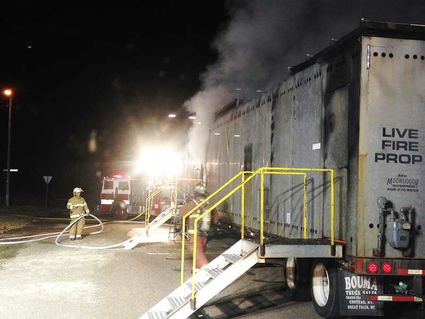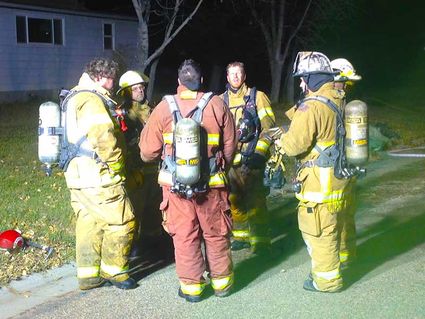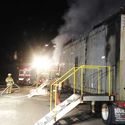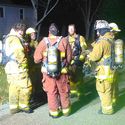Chinook volunteer firefighters train in the 'burn prop'
November 11, 2015

Courtesy Photo
A semi-mounted training module that uses real fire to give firefighters a chance to learn fire behavior in a structure and practice suppressing a dwelling fire.
A group of volunteer firefighters recently spent a training session learning fire behavior and fighting real fires in the 'burn prop,' a mobile training unit designed to give firefighters experience with suppressing a real fire under controlled conditions. The tractor-trailer mounted training unit is one of two provided to local fire departments around the state of Montana through the Fire Training Services Training School (FSTS), a state level agency that is attached to the Extension Service of Montana State University.
Doug Lobaugh, Operations Manager for the Fire School, said, "We learned some time ago that to adequately meet the training needs of our volunteer and career firefighters across such a big state we had to take the training to the firefighters. Most small departments don't have the budgets for extended travel and volunteers can't leave jobs back home." Only about 10% of the training takes place at the academy.
The Fire School serves 467 fire departments around the state. Of the 11,000 members that make up the departments, 96% are volunteers. The Fire School provides training and other support to assure local fire departments have access to the latest firefighting methods.
The burn prop
The burn prop is a semi-trailer mounted unit that is built to simulate a mobile home and a one story house. Lobaugh said most fires that volunteer firefighters will face are either mobile homes or one story dwellings. The burn prop is made of metal so fires can be set without fear of damage to the training unit. There is a top mounted portion to the unit that replicates a sloped rough or flat roof structure, with ventilation devices in place for realism.
Lobaugh said, "Many small fire departments have limited exposure to structural fires. Using the burn prop we can demonstrate fire behavior in a structure and show the firefighters how to suppress a fire with limited water." He explained most firefighting units only can carry about 300-500 gallons of water so learning ways to use minimal water is important, especially in a rural setting.
Chinook Fire Chief Kraig Hansen agreed with Lobaugh's assessment of the need to train for structural fires. Hansen said, "In a typical year we may only see three to five structural fires, yet we need to be prepared to deal with one when it does happen." Hansen added, "Using the burn prop we can create an actual scenario with real fire." Hansen said most fires his department responds to are vehicle fires and extrications, grass fires and responding to smoke smells or possible gas leaks.
Using the burn prop, and its three rooms, Lobaugh explained, "We can set up a fire where the firefighters must enter the first room and search it for possible victims, then move on to the second room to suppress the fire." The firefighters are all wearing their turnout gear and self-contained air packs for the exercises.
Lobaugh added, "We can only do training with fire when the departments are sufficiently familiar with their equipment, know how to set up to fight a fire, have and understand their firefighting plans and understand how to integrate mutual aid when necessary. Mutual aid refers to agreements with other fire departments that allow those departments to come to a scene when needed. Lobaugh said the Chinook firefighters were already in the top five percent of volunteer departments of the state because of the department's continuous training and familiarity with their equipment.
The firefighters view of the training
Ian Davies is one of three captains with the Chinook Fire Department. He has done the simulated training in the burn prop during the last seven years he's been a firefighter, some years doing the exercise more than once.
Davies said, "To me the real value of training in the burn prop is to let firefighters experience a real fire with controls in place to keep them safe." He explained that a pumper truck, with water at the ready and the pump running, is always attached to the burn prop when firefighters are training. He added, "I'm aware of some incidents where a firefighter got too close to the fire and had a problem. With the pumper set up the person tending the pump can push the lever and the sprinkler system in the burn prop immediately suppresses the fire."
Lobaugh also emphasized the importance of having safety measures in place during the training.
Davies agreed with other comments about most rural firefighters having limited exposure to structure fires. He said, "This simulation lets you deal with the initial shock of going into a dark, smoky enclosed area with real fire. Firefighters get to experience exposure to the fire and their own anxiety about fighting a fire. It is a big help to overcome some of the jitters that it's only natural for firefighters to feel." He added that going from room to room and getting a feel for the conditions makes a big difference in how firefighters feel about fighting a structure fire.
Another Chinook firefighter, who went through the training, was Kylee Kaul. Kaul has been a firefighter for about two months and this was her first time in the burn prop-and her first exposure to what it was like to fight a real structural fire. She admitted she was nervous at first. She was especially impressed with the training that allowed participants to learn more about fire behavior. She added, "It was fascinating watching the flames search for an oxygen source."

Courtesy Photo
A group of Chinook firefighters, right, recently completed their annual practice in the burn prop.
Kaul grew up around a family involved with fighting fires. She explained, "My dad had a truck with a 1,600 gallon tank and firefighting equipment. When my dad got a call to go help at a fire, I would sometimes go with him. If I got home later, I would help my mom make sandwiches to take to the fire crews."
She always knew she wanted to be a firefighter, in fact her long term goal is to be a wildland firefighter-fighting the big fires in forests or on great grasslands. She added, "I might even like to be on a hot shot crew, they're the top echelon of wildland fire fighters."
All the Chinook firefighters agreed the practice in the burn prop was critical to preparing them to fight a structural fire, which they will likely encounter at some point. And they remarked how appreciative they were of the Montana Fire School and the training the Fire School staff brings to the fire departments around the state.










